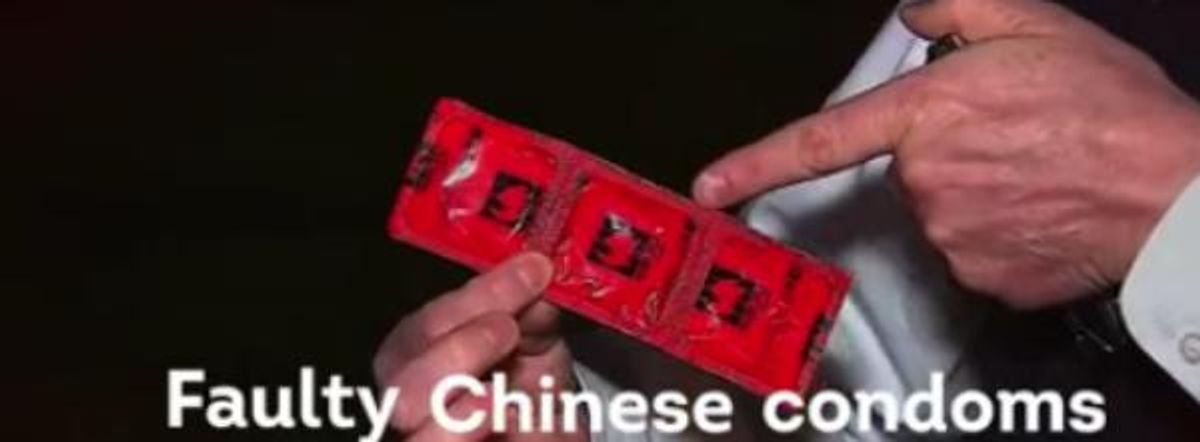“Made in China” is a phrase oftentimes used pejoratively to describe cheap but low-quality goods made in China and then exported in mass quantities to America and other countries. In a country that had a one-child policy for nearly 30 years, though, one product that wouldn’t be expected to be defective has proved faulty. On 23 August 2016, numerous news sources started reporting that Chile discovered 1.2 million condoms their government had imported from China for use in its public health program turned out to be defective.
The Chilean Public Health Institute said that the condoms have a tendency to break, leak lubricant, and that their packaging deteriorates quickly upon handling. Chile originally purchased the condoms to battle HIV, and the Institute had already distributed over 712,000 of the almost 1.2 million defective Kaiju-brand condoms before the problem was discovered. Chilean citizens are being asked not to use the Kaiju condoms.
Kaiju fired back with a Spanish-language statement on their Facebook page that the condoms met all quality control standards when they were imported into Chile in 2014 and 2015 and all of its product lots had been certified by documents signed by Chilean officials. The statement also included the assertion that the condoms are within the normal size range for Chilean standards (we’re not commenting on that last point). Institute Director Alex Figueroa admitted that the problem may be due, at least in part, to incorrect storage.
However, this is not the first time that Chinese condoms have been found defective. In April 2013, Ghanian officials seized more than 110 million Chinese-made condoms after testing determined that they burst too easily. The condoms were also described as being inadequately lubricated and having microscopic holes. As in Chile, the condoms had been imported by the national health service for free distribution as part of an HIV/AIDS prevention program. Approximately 20 million had been distributed before the defects were found. Those condoms were traced back to Henan Xibei Latex Company Limited in central China.
That same month, police in Shanghai announced that they had broken a counterfeit condom manufacturing ring that operated across eight provinces. The bust resulted in the seizure of 3 million fake condoms. The condoms were found to contain toxic heavy metals. “Officers said the lubricating oil used on the condoms at one production line in Henan province was so disgusting that it made them feel sick, according to the People's Daily Online. “The fakes were packaged as popular brands such as Durex and were allegedly made of inexpensive plastic strips and elastic bands. They were sold at motels across the country.
A month later, in May 2013, Chinese police broke another counterfeit condom manufacturing ring based in southeast China’s Fujan province. This scam involved the purchase of raw latex and cheap lubricants, then packaging the unsterilized condoms in bags and boxes featuring more well-known product names such as Durex, Contex, and Kjissbon. In the raid, Chinese police confiscated nearly 5 million already-packaged condoms and another 1,100 pounds of unpackaged contraceptives. When the bust occurred, workers were allegedly found lubricating the condoms with oil — which breaks down latex. The counterfeit condoms were primarily sent to small suppliers and sold via the Internet.
Despite these busts, counterfeit condoms made headlines again in July 2015 when Italian customs seized 600,000 fake Durex “Big Boss” condoms at the Leonardo da Vinci airport. Italian officials said that the condoms were made with poisonous chemical compounds and improperly sterilized materials.
And the U.S. is not immune. Older news articles from 2008 and 2010 report phony condoms being marketed under trade names such as Trojan, Durex, Rough Rider, and Love Card. Although oral and other contraceptives can prevent unwanted pregnancies, condoms have been the first line of defense against sexually-transmitted diseases such as syphilis and HIV/AIDS.
Nevertheless, don’t give up on your trusty Trojans just yet. Approximately 450 million condoms are sold in the U.S. each year. Only a small percentage are likely to be counterfeits. When Consumers Union, which publishes the venerable product testing-and-rating magazine Consumer Reports (CR), tested condoms in 2009, they found that all met international safety standards. Condoms are typically tested by inflating them with 17 or 18 liters of air to see if they burst. All of the 20 brands CR tested met international standards. CR then took the process a step further, inflating condoms with 25 liters of air. At this measure, none of the condoms in 7 brands failed, even after they tested 500-600 condoms per brand. This included varieties from Durex, Trojan, and Lifestyles. CR also submerged the condoms to check for any signs of leaks.
"This isn't a very scandalous story," said Jamie Hirsh, an associate editor of Consumer Reports. None of them failed, all of them are fine, but some of them are even better than fine. If you're looking for the strongest, toughest condom, that's what that extra test gives you."

